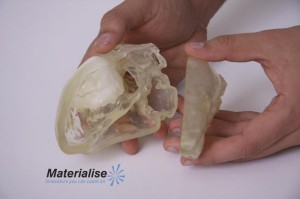Belgian-based 3D printing manufacturer Materialise NV introduced its Materialise Hospital Solution for medical image processing at the RSNA 2014 Meeting. The company’s new Hospital Solution incorporates the Mimics Innovation Suite software, 3D printing services, training and consultation, to help make 3D printing in hospitals safe and accessible.
According to the announcement from Materialise, its 3D printing software and services for anatomical models offers hospitals access to the latest technologies for 3D printing with a comprehensive quality control system to ensure accuracy. Materialise reports that it will provide interested hospitals with consultation on the solution’s available technologies, as well as training for each step of the process.

Holding a 3D printed model in hand gave a cardiologist and surgeon at Cincinnati Children’s Hospital a better understanding of a complex heart tumor.
The Materialise Hospital Solution reportedly allows clinicians to address the unique needs of each individual patient by translating patient-specific data into accurate, tangible models for healthcare. The 3D software and models can be used to explain a patient’s condition to families, assist in diagnosing complex pathologies, enable the review of a plan with a surgical team, and support testing a procedure on the bench before going to the bedside.
“Hospitals are excited about 3D printing, and we want the technology to benefit as many patients as possible,” said Peter Verschueren, business development manager, Materialise. “With nearly 25 years of experience in medical 3D Printing, we are the trusted partner who can help hospitals navigate the opportunities and the best way to achieve their goals in a safe, economical and sustainable way. We’re confident that our Hospital Solution of software, services, consultation and training will achieve this.”
The company believes that 3D printing can assist in improving clinical outcomes, providing evidence, and reducing costs. Though 3D imaging is a powerful resource to assist in diagnosing patients, Materialise reports that clinicians also are collaborating with their radiology departments to use 3D imaging to assist in treating patients. As an example, Materialise cited a case where a young heart patient’s care team gained a better understanding of his heart tumor through the 3D printed model of it. The evidence provided by the 3D model enabled them to redirect his treatment towards an electrophysiology study and catheter ablation over a risky surgical resection of the tumor.
Materialise explains that when surgeons can hold a patient-specific anatomical model in their hands, it can help them to visualize a treatment approach that will work best for the unique needs of that individual patient.
For more information on the Materialise Hospital Solution, visit the Materialise website.
Photo credit: PRNewsFoto/Materialise NV




